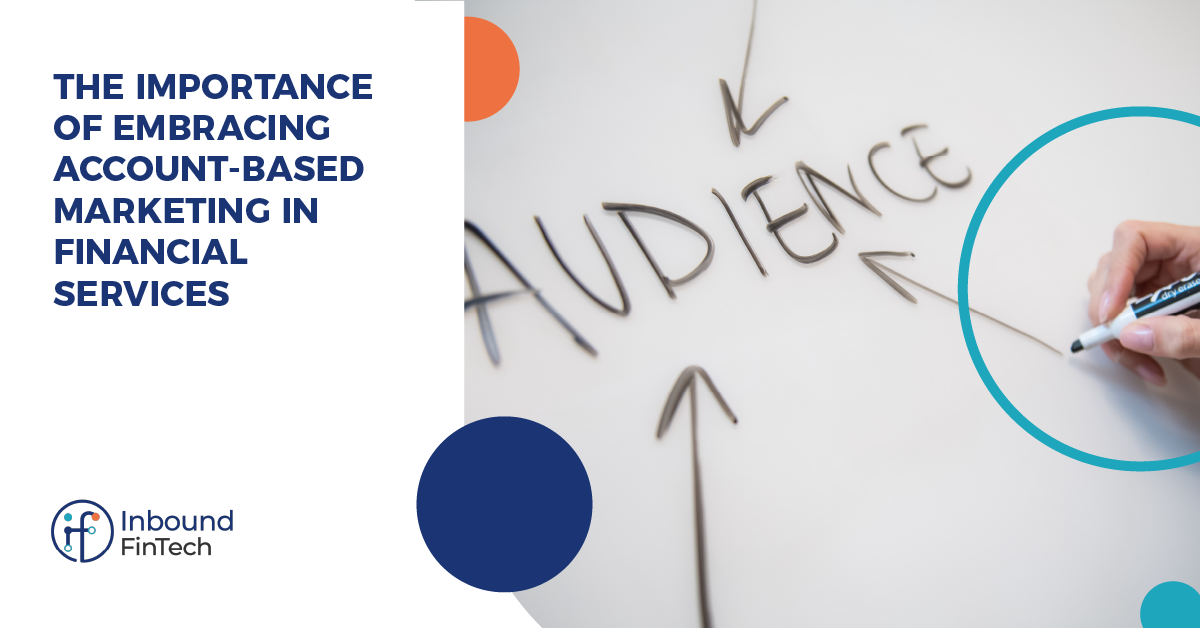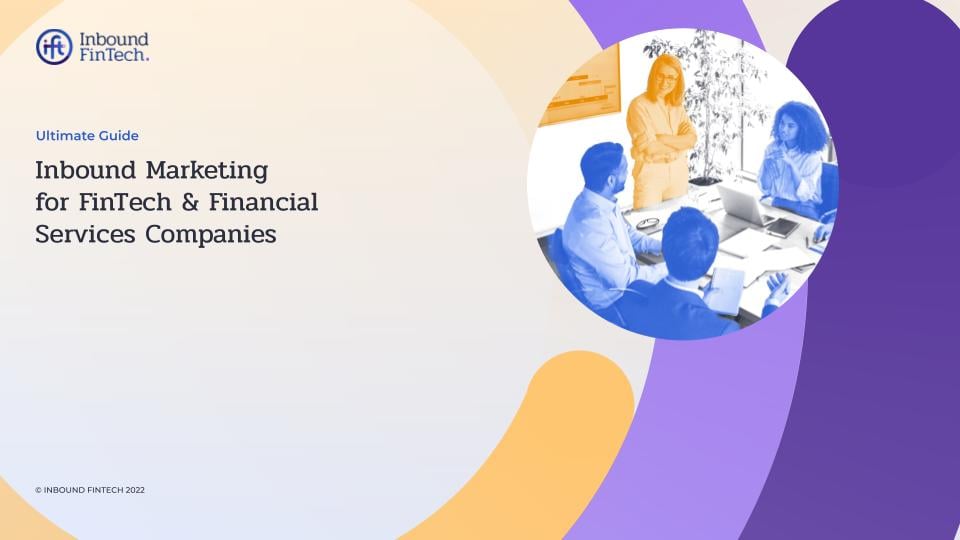Attracting and nurturing quality prospects (or leads) to your business is a key objective of any B2B marketing strategy. But with the ongoing shift in buying behaviour and expectations and increasingly more individuals in B2B decision-making positions, guaranteeing campaign success can be difficult. Account-based marketing has emerged as a vital part of a Financial Services marketer’s toolkit, to target key accounts and decision-makers within organisations.
But what exactly is account-based marketing and how does it work? We explore the ins and outs of the approach and reveal how account-based marketing strategies can deliver a big impact on your lead nurturing and conversion capabilities.
The role of account-based marketing in B2B marketing strategies
What is account-based marketing?
Account-based marketing (or ABM) has proven to be an effective strategy for improving acquisitions and closing deals - 87% of marketers who measure ROI have stated that ABM outperforms their other marketing investments.
HubSpot defines ABM as a “focused growth strategy in which Marketing and Sales collaborate to create personalised buying experiences for a mutually-identified set of high-value accounts”. As a highly-targeted marketing approach that prioritises building and maintaining meaningful customer relationships, ABM allows you to focus efforts on your core target audience, address them personally, and prioritise quality lead generation over quantity of leads.
A necessary prerequisite for ABM success is full alignment between the traditionally siloed departments of marketing and sales, where, by their powers combined, they can identify, work and communicate with high-value accounts, leading to shortened sales cycles and greater ROI.
How does account-based marketing compare with inbound marketing?
While inbound marketing and account-based marketing are different, they can be complementary strategies. Inbound lays the groundwork for lead generation across the buyer’s journey through identifying key buyer personas, creating valuable content for those personas, optimising SEO and prioritising a delightful customer experience.
ABM takes the efforts of inbound marketing to the next level by building on key personas with highly-targeted accounts and leveraging the valuable content, optimised SEO and killer customer experience of inbound to attract the high-value audience and convert sales-ready prospects more quickly.
This acceleration of the inbound methodology means a business’ most desirable accounts move through the buyer’s journey more swiftly, the lifecycle of content can be extended by being leveraged for both strategies and the tools used for inbound marketing can provide insights valuable to your ABM strategy.
Why targeting key accounts and decision-makers is crucial for Financial Services businesses
The Financial Services industry is still in the process of finding the best way to navigate a post-COVID world and recover some of the losses incurred over the last two years as a result of the pandemic. Account-based marketing can help to get businesses back on track and supercharge pipelines.
B2B buying decisions have become more complex and the number of stakeholders in the buying decision has increased. Now, an average of 6.8 people are involved in a single buying decision. For Financial Services businesses, relationships need to be established and built with this entire buying committee. What’s more, businesses need to be in tune with these individuals’ needs consistently and stand out from competitors, while getting the most out of their marketing budgets.
Key benefits of account-based marketing in Financial Services
1. Reduced costs
When it comes to account-based marketing, quality beats quantity. It’s a one-to-one or one-to-few approach. You only target accounts with the potential to provide significant value to your business. With ABM, because you’re focusing your efforts and resources on engaging and delighting specific high-value target accounts, your sales cycle is streamlined - saving time and costs.
2. Better quality of leads
Rather than experimenting with various approaches to attract and qualify many less-qualified leads from a large lead pool, ABM ensures you’re targeting the right high-value accounts for your business. Additionally, because you’ve taken the time to build trust and relationships with prospects, you’ll retain those valuable client accounts for longer, ultimately expanding your business. And retaining clients is a lot cheaper than obtaining them.
3. Increased return on marketing efforts
When done right, account-based marketing tends to be more popular with Sales because it aligns marketing resources with a defined set of accounts in a way that’s relevant and valuable to the accounts, and the Sales teams responsible for them.
Given the relationship-based nature of the Financial Services industry, marketers are increasingly seeing the benefit of personalising their approaches for key accounts, and because ABM requires complete alignment between Marketing and Sales teams and processes, all stakeholders can deliver personalised communication, campaigns, educational information and product information at the right time, across the buyer’s journey. This means marketing resources and efforts are optimised and fully exploited.
4. Improved customer experience
Account-based marketing requires that content, product information, communications and campaigns be personalised to your target audience. Through this active personalisation, you not only tailor your content and interactions to show high-value accounts how your specific services and solutions meet their challenges, but you also maximise your brand’s relevance. ABM allows you to position your business as the ideal option for target accounts, with every touchpoint optimised for their specific needs, resulting in an improved customer experience.
Additionally, thanks to these personalised, attentive experiences, key accounts will become more loyal to your business with each interaction, and loyal customers make for the best brand advocates!
What tools can businesses use in their ABM strategy?
Account-based marketing doesn’t require specific tools to be effective, but rather a different approach to how you use your existing tools. You need to leverage these tools, such as your CRM, LinkedIn or dedicated ABM software, to glean data insights that can inform your ABM strategy. The approach depends on accurate data insights for accurate account identifying and targeting, and better use of the technology at your disposal.
Harness your CRM’s account-based marketing capabilities
If you use a CRM or CMS system in your marketing and sales processes, being aware of what the tool offers and how these features can be best used for an account-based marketing strategy can help you get the most out of it. Platforms like HubSpot CRM offer a range of capabilities that accelerate ABM strategies, including the following:
- Workflow templates
- AI-powered recommendations for target accounts
- LinkedIn Ads integration
- LinkedIn Sales Navigator integration
- Target Accounts tool
- Integrations with tools like Demandbase and RollWorks
- Data dashboards - enabling your ABM strategy from account identification through to KPI tracking
When aligning Sales and Marketing teams and processes, ensure both teams are aware of how the other uses your CRM platform so they have a comprehensive understanding of how its capabilities can best be harnessed to meet individual and shared objectives.
Leverage LinkedIn more effectively
If you’re a B2B business, LinkedIn should already be a tool in your marketing arsenal. For many teams, LinkedIn is foundational to their account-based marketing strategies. The platform’s vast audience targeting capabilities allow you to precisely define target accounts across metrics like job title and functionality, seniority, company and interests.
It’s worthwhile cross-referencing your LinkedIn audiences with those target accounts handled by your Sales team - again, through the alignment process, Sales should help Marketing best define the target accounts by sharing who they work with and what these accounts look like. Once you’ve defined and added your target accounts, you can draw on LinkedIn’s advertising features to best reach them and start generating leads, including sponsored content, InMail ads, dynamic ads and display ads, all targeted to your highly specific target accounts.
How IFT can support Financial Services businesses with ABM
The key objective of account-based marketing is to drive quality leads and nurture them effectively through to conversion. And Inbound FinTech helps Financial Services businesses to do just that. Through hyper-targeted ABM campaigns, our marketing experts transform lead generation strategies to qualify sales-ready prospects.
Drawing on our award-winning strategies and an inbound methodology, and leveraging LinkedIn’s business tools and HubSpot’s automation capabilities, we help companies in the Financial Services and FinTech sector to identify valuable prospects, generate and nurture leads, and achieve sales conversions.
Our LinkedIn marketing and ABM services include:
- Target audience list building
- Content creation or repurposing
- LinkedIn Ads planning, creation and implementation
- Lead nurturing strategies
- Marketing and Sales alignment
- Sales enablement strategy and support
Summary
In Financial Services, account-based marketing is a key method for maximising your marketing efforts and generating new business. To stand out from competitors means to know who your most suitable and valuable accounts are and reach key decision-makers with a tailored and highly targeted approach. ABM strategies leverage the capabilities of your sales and marketing efforts to reach the right people and ensure the best possible ROI.
Whether you’re exploring how account-based marketing can help your Financial Services business or ready to start planning your ABM strategy, Inbound FinTech can help you ensure your campaigns are a success. Reach out to our ABM experts and start generating the best possible leads for your business.
Inbound FinTech is an award-winning digital growth agency and Elite HubSpot Partner. We help FinTech and Financial Services businesses significantly improve their marketing performance. Through our proven inbound marketing and account-based marketing tactics and strategies, we transform your lead generation process, boost website traffic and attract your ideal customers, generating qualified leads and increasing your sales opportunities.




%20(3).png)






















.png)





-1.png)




